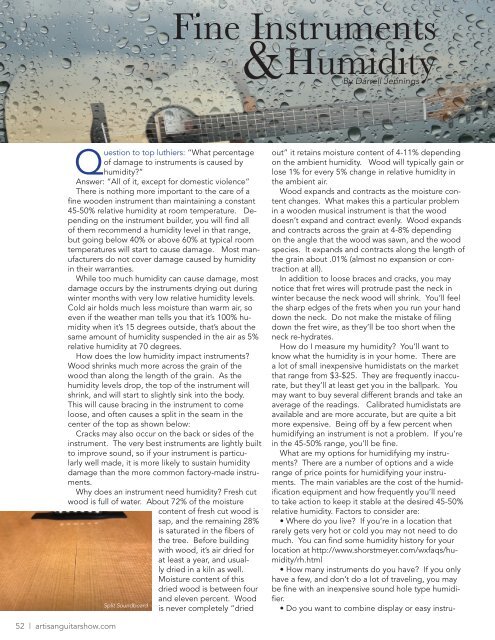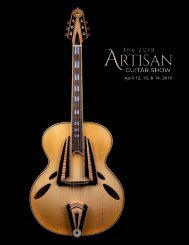2018 AGS Magazine
Magazine for the 2018 Artisan Guitar Show
Magazine for the 2018 Artisan Guitar Show
You also want an ePaper? Increase the reach of your titles
YUMPU automatically turns print PDFs into web optimized ePapers that Google loves.
Fine Instruments<br />
Humidity<br />
&<br />
By Darrell Jennings<br />
Question to top luthiers: “What percentage<br />
of damage to instruments is caused by<br />
humidity?”<br />
Answer: “All of it, except for domestic violence”<br />
There is nothing more important to the care of a<br />
fine wooden instrument than maintaining a constant<br />
45-50% relative humidity at room temperature. Depending<br />
on the instrument builder, you will find all<br />
of them recommend a humidity level in that range,<br />
but going below 40% or above 60% at typical room<br />
temperatures will start to cause damage. Most manufacturers<br />
do not cover damage caused by humidity<br />
in their warranties.<br />
While too much humidity can cause damage, most<br />
damage occurs by the instruments drying out during<br />
winter months with very low relative humidity levels.<br />
Cold air holds much less moisture than warm air, so<br />
even if the weather man tells you that it’s 100% humidity<br />
when it’s 15 degrees outside, that’s about the<br />
same amount of humidity suspended in the air as 5%<br />
relative humidity at 70 degrees.<br />
How does the low humidity impact instruments?<br />
Wood shrinks much more across the grain of the<br />
wood than along the length of the grain. As the<br />
humidity levels drop, the top of the instrument will<br />
shrink, and will start to slightly sink into the body.<br />
This will cause bracing in the instrument to come<br />
loose, and often causes a split in the seam in the<br />
center of the top as shown below:<br />
Cracks may also occur on the back or sides of the<br />
instrument. The very best instruments are lightly built<br />
to improve sound, so if your instrument is particularly<br />
well made, it is more likely to sustain humidity<br />
damage than the more common factory-made instruments.<br />
Why does an instrument need humidity? Fresh cut<br />
wood is full of water. About 72% of the moisture<br />
content of fresh cut wood is<br />
sap, and the remaining 28%<br />
is saturated in the fibers of<br />
the tree. Before building<br />
with wood, it’s air dried for<br />
at least a year, and usually<br />
dried in a kiln as well.<br />
Moisture content of this<br />
dried wood is between four<br />
and eleven percent. Wood<br />
Split Soundboard<br />
is never completely “dried<br />
out” it retains moisture content of 4-11% depending<br />
on the ambient humidity. Wood will typically gain or<br />
lose 1% for every 5% change in relative humidity in<br />
the ambient air.<br />
Wood expands and contracts as the moisture content<br />
changes. What makes this a particular problem<br />
in a wooden musical instrument is that the wood<br />
doesn’t expand and contract evenly. Wood expands<br />
and contracts across the grain at 4-8% depending<br />
on the angle that the wood was sawn, and the wood<br />
species. It expands and contracts along the length of<br />
the grain about .01% (almost no expansion or contraction<br />
at all).<br />
In addition to loose braces and cracks, you may<br />
notice that fret wires will protrude past the neck in<br />
winter because the neck wood will shrink. You’ll feel<br />
the sharp edges of the frets when you run your hand<br />
down the neck. Do not make the mistake of filing<br />
down the fret wire, as they’ll be too short when the<br />
neck re-hydrates.<br />
How do I measure my humidity? You’ll want to<br />
know what the humidity is in your home. There are<br />
a lot of small inexpensive humidistats on the market<br />
that range from $3-$25. They are frequently inaccurate,<br />
but they’ll at least get you in the ballpark. You<br />
may want to buy several different brands and take an<br />
average of the readings. Calibrated humidistats are<br />
available and are more accurate, but are quite a bit<br />
more expensive. Being off by a few percent when<br />
humidifying an instrument is not a problem. If you’re<br />
in the 45-50% range, you’ll be fine.<br />
What are my options for humidifying my instruments?<br />
There are a number of options and a wide<br />
range of price points for humidifying your instruments.<br />
The main variables are the cost of the humidification<br />
equipment and how frequently you’ll need<br />
to take action to keep it stable at the desired 45-50%<br />
relative humidity. Factors to consider are:<br />
• Where do you live? If you’re in a location that<br />
rarely gets very hot or cold you may not need to do<br />
much. You can find some humidity history for your<br />
location at http://www.shorstmeyer.com/wxfaqs/humidity/rh.html<br />
• How many instruments do you have? If you only<br />
have a few, and don’t do a lot of traveling, you may<br />
be fine with an inexpensive sound hole type humidifier.<br />
• Do you want to combine display or easy instru-<br />
52 | artisanguitarshow.com




